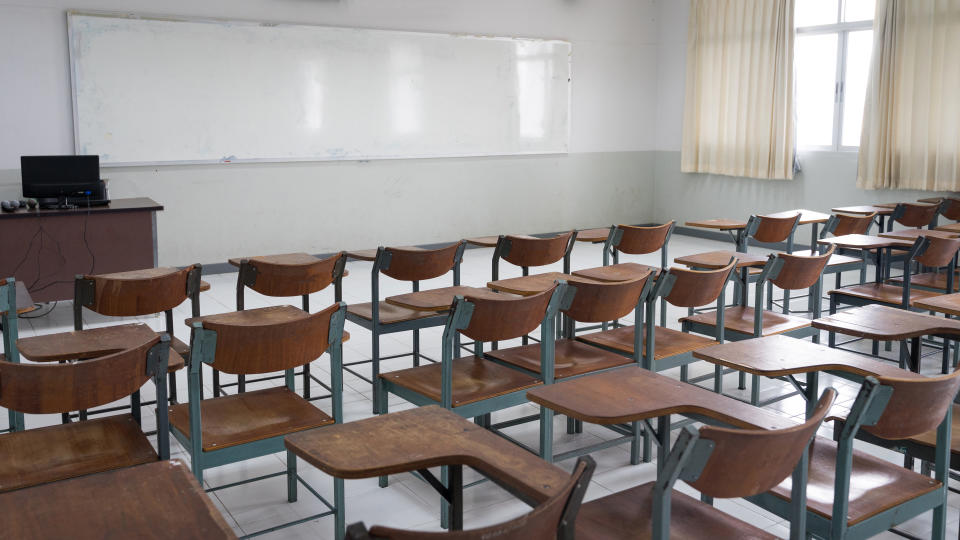As the coronavirus forces college classes online, it's the students whose lives are jarred most
Working on a college campus is unlike working just about anywhere else. There’s a breeziness to the place, a kind of lightness. Maybe it’s the energy of being surrounded by young people on the cusp of growing into their full selves, of becoming who they will be. But whatever it is, exactly, it’s the students who make it so.
Today, almost every campus in the country is empty. An empty campus is an eerie place. I went back to the one where I teach last week, so that my toddler could ride his big wheel on nice, flat surfaces without us having to go near anyone else, popping our social distancing bubble. Like much of America now, it looked abandoned. The buildings were still stately and the grass still irrepressibly green and tidy, but it was vacant and quiet and that crackle was gone.
The experience is surely more jarring for the students than it is for us, the faculty. The disruption to the lives of college students — especially seniors, who had been readying to return to campus after spring break to take their victory lap of celebration and recognition and parties — is greater than that of most others who aren’t sick.
Imagine losing access to your home, your occupation, most of your friends and possibly a partner, all at once, with just a few hours’ warning, or none at all.
That’s what it’s like for them. Physical classes continued through March 13, since, miraculously, there had been no positive coronavirus cases in our college community or our county. We already knew that spring break was extended by a second week, and then the rest of the semester was moved online. The students wouldn’t be coming back to campus, their home for most of the year. Not for a long time anyway, if at all.

Well, a lot of them came back to move out of their dorms. They came at appointed times, in controlled numbers, to preserve social distancing protocols. They got to evacuate their stuff and say goodbye to the place, but probably not their friends.
In a physical sense, they’re not in school anymore. They’re essentially home for a six-month summer, if they aren’t graduating. Commencement has been postponed, with the college making a commitment to hold it when it’s safe. Most students are back living with their parents for a much longer period than either they or those parents could have anticipated. That brings its own strain — they’re grown-ups of their own now, largely independent.
Online classes are a wholly different experience, communicated through a screen rather than sharing a space and going through it together, teacher and students, a jumble of live humans. The faculty pulled together over spring break, frantically converting courses to deliver the best possible academic alternative online, threading the needle between flexibility and rigor. It’s easier for some classes than others. One of my courses is a lecture class, which transitions easily. Another consisted entirely of covering Marist games for our student-run sports media outlet. That’s been a much tougher nut to crack.
We try to create a learning experience that retains its humanity. But we’ve been discouraged from holding our classes over live video feeds like Zoom or WebEx. After all, they’re not as readily accessible to everyone, as not everyone’s living conditions, care responsibilities and internet connections are created equal.

Even students with strong Wi-Fi signals might suddenly find themselves in a household where four other people are chopping up the bandwidth all day long as well. I know of Chinese students at a different college being forced to follow live video lectures in the dead of night using a rickety Wi-Fi connection at the hotel in which their government quarantined them upon returning home.
Some professors record videos, or record their voice over slideshows. I’ve chosen to write out my lectures — spicing them up with the pictures and videos I would normally show in class — in the belief that it’s harder to half-read something than to half-watch something.
There have been upsides. We moved my American Sports Literature seminar onto Discord, a gaming community platform, and it’s given my students more room to opine without the time pressure of a class period, which they’ve embraced.
I’ve moved my office hours, when students tend to amble in at their leisure, onto Skype. I try to keep it as light as I do in person. My toddler makes guest appearances, pushing me out of the way to show off his Duplo creations and ask my students their names and favorite vehicles. This whole situation has made for more empathetic conversation, and seeing students’ faces, usually against a backdrop of their childhood rooms, is nice. I’m awed by their resilience. If they’re struggling, they seldom show it. Then again, such are 20-year-olds.
But I miss the in-person interactions. They do too, I suspect.
It’s harder to joke with students through a pair of cameras, harder to reassure them when they get anxious, harder to advise them on courses and careers, harder to make them feel like you’re on their team.
Hard as it is for us, the teachers, we haven’t been ripped from our surroundings. We’re still home, at least.
Leander Schaerlaeckens is a Yahoo Sports soccer columnist and a sports communication lecturer at Marist College. Follow him on Twitter @LeanderAlphabet.
More from Yahoo Sports:



